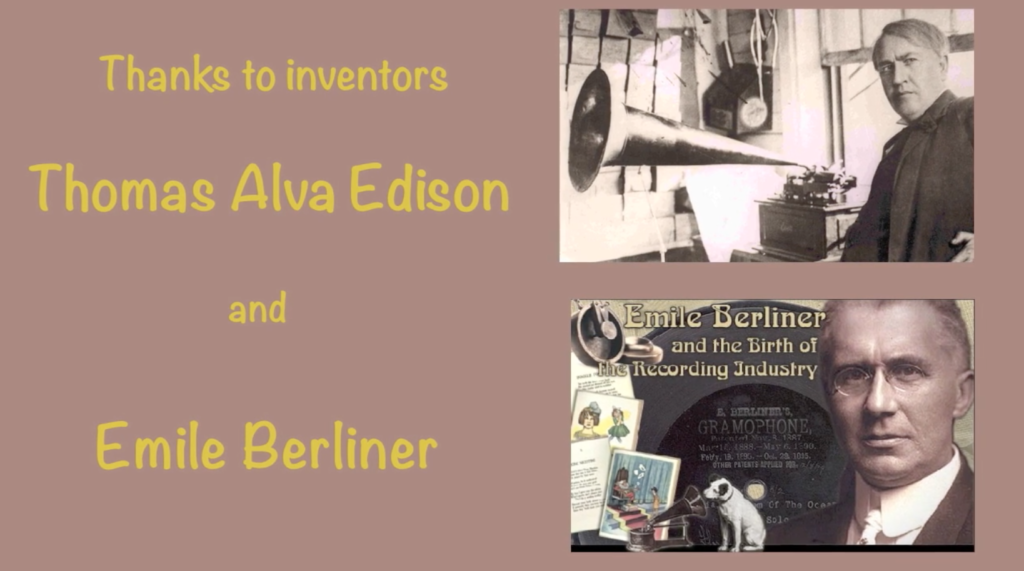Background
The first sound recording devices were envisioned in the 1870s. French citizen Charles Cros came up with a proposal for a “Paleophone” (“voix du passé“, = “voice of the past”) in 1877 which was presented to the French Academy of Sciences. His device was never produced. Independently, Thomas Edison demonstrated his first prototype of the phonograph at the office of the Scientific American in 1877 and patented it in 1878. Emile Berliner began his research into sound recording by exploring the practicality of Cros’s concepts. In 1887 he patented his device which he named “gramophone.” It is this type of device that we demonstrate in our video.
Record Sizes
Emile Berliner began making 5-inch “gramophone” (a name coined by Berliner) discs in Germany in 1889. In 1894 Berliner formed an American company to make single-sided 7-inch discs and compatible players.
Recording Speeds
Recording speeds varied from 72 to 86 revolutions per minute (RPM) and were not standardized until the electrical era. In 1925, 78.26 rpm was chosen as a standard for motorized phonographs, because it was suitable for most existing records, and was easily achieved using a standard 3600-rpm motor and 46-tooth gear (78.26 = 3600/46).
Recording Substrates
Discs were made and coated with a variety of materials. Edison’s very first recording device used tin foil. Some of the early records used glass and celluloid but shellac eventually became the most common material. Generally 78s are made of a brittle material which uses a shellac resin (thus their other name is shellac records).
What is Shellac?
Shellac is a resinous product obtained from the secretion of the female “lac bug” (Kerria lacca) on trees. It is mainly produced in the forests of India and Thailand. The dry flake processed shellac is dissolved in ethanol to obtain liquid shellac.
Playing Times
The durations of 78 RPM recordings is about three to five minutes per side, depending on the disc size. If it is a 12 inch disc, it usually holds four to five minutes of music. A ten inch typically holds three minutes. Edison’s Diamond Discs were available 1910 in 7, 10, 12, 14, 16, and 21 inch formats. They were played at around 78 rpm and contained up to 8 minutes of sound.
Emile Berliner’s first “gramophone” discs in Germany were initially made of celluloid before switching to a hard rubber compound. They were played on a hand-cranked turntable made by the toymakers Kämmer & Reinhardt.
The venture with Kämmer & Reinhardt didn’t last long, but in 1894 Berliner formed the United States Gramophone Company in Washington, D.C. to make single-sided 7-inch discs and the machines to play them on. The discs initially used a hard-rubber compound before switching to shellac in 1895 and played for around 2 minutes with speed varying from 60 rpm to 75 rpm.
Discs had several advantages over the brown wax cylinders available at the time, including durability and the ability to mass-produce copies.
Berliner also had interests in other countries, with a company in England (The Gramophone Company), Germany (Deutsche Grammophon), and Canada (E. Berliner Gramophone of Canada) among others.
Several illegal competitors began to sell discs and machines by the late 1890s, including the Zonophone made by the Universal Talking Machine Company. A lawsuit by the Universal Talking Machine Company forced Berliner to abandon his US operations and transfer the rights to Eldridge Johnson, who manufactured Gramophone machines for Berliner. Johnson formed the Consolidated Talking Machine Company (producing the “Improved Gram-O-Phone Record”) before a name change in 1901 to the Victor Talking Machine Company.
Victor introduced the 10-inch 78 rpm record in 1901, and appears to have dropped the 7-inch size by 1908. However, the 7-inch size never fully died out, and was briefly revived in 1915 by the Emerson Record Company in the US, and later by Victory Records in 1928 for the UK market. Even after this, the size was still used for 78 rpm records, often for children’s records, a late example being Happy Time Records in the 1960s (albeit on vinyl rather than shellac) before the 78 rpm speed ceased being used.
Sources:
1860 ‘Phonautograph’ Is Earliest Known Recording
Origins of Sound Recording: The Inventors — Charles Cros: The Paléophone Process
Phonograph—Wikipedia article
“Thomas Edison’s Amberola,” by Dave Rambow
Online Etymology Dictionary: phonograph
Emile Berliner—Wikipedia article
The Victor-Victrola Page: “Basics of the Acoustic Phonograph”
Victrola.com: “What Is An Acoustic Phonograph?”
Museum of Obsolete Media: 7-inch 78 rpm record (1894 – 1960s)
Yale University Music Library: “The History of 78 RPM Recordings”
Gray’s Auctioneers: “The Evolution of Records: From Shellac to Vinyl”
ScienceDirect.com: “Shellac”

